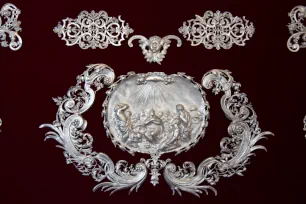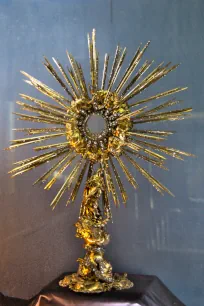The Loreto in Prague is a pilgrimage site that was first built in 1626 and later expanded into the Baroque complex that we see today. It was built on behalf of Caroline Lobkowicz, who was obsessed by the Santa Casa in Loreto, Italy.



The Loreto Cult
The Santa Casa (Holy House) is the name of the house in Nazareth, Palestine, where Mary supposedly received the news she would conceive a son. Crusaders built a church over the house, which was destroyed in 1263 by the army of the Egyptian Sultan Baibars.
The house itself miraculously survived. To prevent its destruction, pilgrims dismantled the house in 1291 and the stones were transported to Croatia by the Greek Angeli family. Their name, Angeli (meaning angels) probably led to the legend that angels moved the house to a safe location. The house was later transported to Loreto in Italy, where it was rebuilt in 1294 and is still venerated to this day.
During the Counter-Reformation, copies of the Holy House were built all over Europe. Fifty such shrines were built in the Czech Lands alone. Of those, the Prague Loreto is the most important.
The Prague Loreto
Construction of the Prague Loreto started in 1626 after a design by the Italian architect Giovanni Batista Orsi and was financed by Baroness Catherine of the wealthy Lobkowitz family. The ornate Baroque facade was added in 1721-1723. It was designed by Christoph Dientzenhofer and completed by his son Kilian Ignaz.
Unlike Italy’s Loreto, where the Santa Casa resides inside a church, here a complex was built around the Santa Casa, which takes up a prime position in the middle of a cloister. The church is situated right behind the shrine.
Santa Casa



The Santa Casa is an almost exact copy of the original and was completed in 1631. The exterior of the rectangular brick building was originally decorated with paintings. Thirty years later the house was enveloped in a mantle of stucco with an abundance of Corinthian pilasters, statues and reliefs which depict the life of Mary, the legend of the Santa Casa, and prophets from the Old Testament.
Inside the Santa Casa is a wooden statue of the Madonna behind an ornate silver altar with several reliquaries, all created in the seventeenth century. The murals on the walls are from the same period.

St. Anthony of Padua

Church and chapels
The Santa Casa is positioned at the center of a cloister enclosed by a two-story arcade. The lower story, which now contains chapels, was originally built around 1670 as a shelter for pilgrims. The second story was added in the 1740s after a design by Kilian Ignaz Dientzenhofer.
The cloister chapels are decorated with beautiful frescoes, paintings and statues. The most famous chapel is the one in the southwest corner, which features a crucifix of the bearded St. Wilgefortis, who according to legend miraculously grew a beard to avoid being married to a pagan king.
On the east side is the Church of the Nativity of Our Lord which boasts an over-abundant Rococo interior decorated with paintings, gilded stucco, ceiling frescoes, multicolored marble pillars and numerous statues of cherubs. Construction of the church started in 1717 to a design by Christoph Dientzenhofer. His son finalized the first phase of the construction. The church was finally completed in 1738 by Johann Georg Achbauer, Christoph’s stepson.
Treasury
A highlight of the Loreto is the treasury, which occupies the upper floor of the cloister. Its most valuable piece is the so-called Sun of Prague, a monstrance with 6 222 diamonds. It was made in 1696-1699 in Vienna. The diamonds were bequeathed by Countess Ludmila of Kolowrat, who had received them as a wedding gift.
Other interesting treasures include a wooden altar, a silver tabernacle, a medieval chalice, crowns for the Madonna statue, large reliquaries, miters studded with diamonds and pearls, and several more monstrances.
Carillon
Above the main entrance to the Loreto rises a Baroque bell tower that houses a 27-bell carillon. The bells were cast in Amsterdam in 1683-1694 and rang for the first time in 1695. Today, it is one of the last authentic carillons from the Baroque era.
- Next: Petrin Hill
- More Sights & Attractions in Prague

